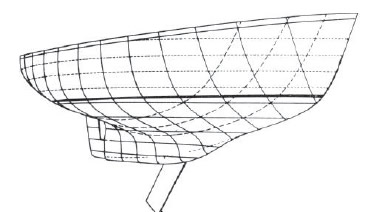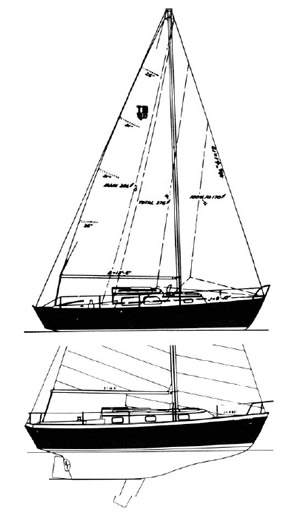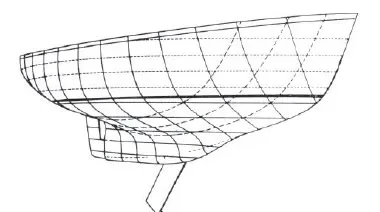
380
When a boat stays in production for 18 years, it is safe to assume that the builder is doing something right, and that the original design had more than a little merit.
The Tartan 27 was one of the early small production fiberglass cruisers, entering production in 1961. About 700 27 s were built before construction stopped in 1979.
For her day, the Tartan 27 was a roomy 27-footer, in-corporating almost 6′ headroom, heavy construction, more than adequate inboard power, and the feel of a much larger boat than her overall length suggested. Her shoal draft made the boat extremely popular in areas of shallow water, such as the Chesapeake Bay, and active class associations still flourish in Lake Erie, the Chesapeake, and Long Island Sound.
As with any boat in production for a number of years, many changes were made in the Tartan 27 during its pro-duction history. The most radical of these was an entirely new deck molding for the last two years of production, which greatly increased interior volume, but which also eliminated the stepped deckhouse that gave older Tartan 27s so much of their character. Tartan 27s with the modern straight deckhouse and raised sheer look very much like any other modern 27-footer.
Exterior Cosmetics
On older Tartan 27s, crazing of the gelcoat of both decks and hull are quite common. In addition, 15 years or more of polishing has usually worn the topside gelcoat quite thin, and dark topsides are likely to be seriously faded. Since the boats have held their value well — a 1970 boat cost about $13,000 new, and should bring about $17,000 today — the boat is a good candidate for a polyurethane paint job,
Depending on the degree of preparation required, this could cost anywhere from $1500 to $3000 for a good pro-fessional job, or even more if considerable glazing of a badly crazed hull is required. If you plan to keep the boat for more than two or three years, the paint job would pro-bably pay off, for the condition of the boat is likely to be as much a determinant of the price you get as its actual age.
If the decks are to be painted, painting the nonskid areas a darker color than the surrounding smooth gelcoat would be a significant visual improvement. Iif the nonskid is bad-ly worn, the boat would benefit by laying new nonskid, as described in the May issue of Better Boat.
Before the new deck molding was introduced, the 27 had attractive teak coarnings. The fiberglass cockpit coam-ings of newer models are quite drab, and could be relieved by a teak overlay along the flat top of the coaming. Cap the coaming from the deckhouse all the way aft, using solid teak about 1/2″ thick. Use short stainless steel self tappers, counterboring the teak 1/4″ to take a 3/8″ or 1/2″ bung. Bed the teak thoroughly in black polysulphide after sealing the bottom surface with a wood sealer such as In-terlux 1026.
Structural and Safety Features
Although the Tartan 27 is a sturdy little boat, several features need modification if the boat is to be considered a serious pocket cruiser.
Early boats have through hull fittings that consist of gate valves screwed onto threaded brass pipe nipples glassed into the hull. While this gives a nice, flush exterior surface, it is an unsuitable solution to the through hull problem for a 20 year old boat used in salt water. We consider this arrangement schlocky in a new boat, and unsafe in an older boat, where the dezincification of the brass pipe nip-ple is almost inevitable. Replace all through hull fittings of this type with real through hull fittings and seacocks. If you choose to recess them flush, you’ll be in for some work (see BB, February 1984, but we consider this replacement a high priority. More than one boat has sunk when a corroded brass pipe nipple failed.
We would also suggest replacing the cockpit scuppers with larger drains, particularly on those boats that have two cockpit drains leading to a single discharge pipe.
Ironically, small boats usually need bigger cockpit drains than larger boats. Because the boats are smaller, with the cockpit closer to the water, the cockpit is more likely to be flooded in severe weather. Since the cockpit is likely to be proportionally larger in a 27-footer than a &-footer, a large volume of water in the cockpit of the smaller boat has much more effect on the bouyancy of the smaller boat.
For the comfort of those belowdecks, the sliding com-panionway hatch should be fitted with a seahood. This can be molded of fiberglass, or fabricated from wood and aluminum sheet. Making a seahood will be the subject of a future article in Better Boat.
Running lights should be updated with new international-type lights, eliminating the tiny lights mounted on the dorade boxes of older boats — a position guaranteed to be blocked by the genoa. We would mount the new running lights on the bow pulpit and the stern rail of boats so equipped. If you have an older Tartan 27 without a stern rail, attach the stern light to the top of the teak taffrail, in the same place as the original stern light. Although there are plywood inserts in the otherwise balsa-cored deck in the way of hardware, no backing plates are used on the underside of the deck to distribute load. Installing proper backing plates will lessen the likelihood of local stress cracks and delamination of the deck skin from its balsa core.

373
Engines
Until the early 1970’s, the Tartan 27 was equipped with the workhorse Atomic Four gasoline inboard. The smooth-running Atomic Bomb provides more than enough power for the boat. In fact, the boat reaches hull speed at about half throttle.
Many of these engines are now 20 years old, and in need of replacement or overhaul. If you plan to keep the boat, consideration should be given to replacing the old gas engine with a diesel. For the sake of comparison, a 1976 Tartan 27 with a 12 horse Farymann diesel com-mands about $2500 more than the same boat with an Atomic Four. Many of today’s boat buyers have only been in the boating market for the last decade, when the diesel engine has completely replaced gas, and simply won’t buy a boat with a gasoline engine.
Ironically, we don’t think that the single cylinder Farymann diesel used by Tartan was a particularly good engine, although at the time there were few choices available. Owners of Tartan 27s with Farymann diesels complain of noise, vibration, and expensive replacement parts.
Instead, consider the Universal Model 18, a two-cylinder engine rated at 14 horsepower and designed as a direct replacement for the Atomic Four. Other small diesels such as the Yanmar 2GMF could be considered, but extensive modifications to the engine beds might be required.
The Atomic Four was hard-mounted, and could be because of its smooth-running four cylinder configuration. Small diesels must be flex-mounted because of their vibra-tion, but this has the disadvantage of transmitting vibra-tion to the shaft log. On diesel-equipped boats, a shock-absorbing flexible coupling is a must.
For racing or long distance cruising, the propellor shaft should be marked so that the prop can be aligned in the aperture in order to reduce drag.
If you’re going from gas to diesel, there’s a good chance the fuel tank will have to be replaced. The Tartan 27 has used tanks of tinned copper, monel, and steel, as well as aluminum for diesel installation. Only monel or aluminum are suitable when going to diesel.
At the same time, replace the old iron exhaust system with a simple, modern waterlift system of fiberglass or stainless steel, with rubber hose instead of steel pipe. This type of system is both quieter and longer lived, as long as it is carefully installed, paying strict attention to the amount of lift required and the routing of the water injection system. A waterlift system can be installed even if the engine is not replaced. With the engine removed, additional insulation can be fitted to the icebox. The icebox is large, but typically of older production boats, has far too little insulation, par-ticularly considering its location next to the engine compartment.

286
Interior
On the inside, the Tartan 27 is really two boats: the original doghouse deckhouse version, and the later raised sheer version.
What the later boat lost in esthestics it made up in func-tion in the form of dramatically improved interior volume. Older Tartan 27s have poor sitting headroom in both the dinette and quarterberth, a problem that appears to defy solution. In addition, the location of the galley along the starboard side of older boats is a poor one with limited headroom for the cook, and too little ventilation.
Much of the interior improvement done by Tartan 27 owners consists of modifications to the galley to make it handier for the cook. The aft bulkhead between the quarter berth and galley should be fitted with a dropleaf sideboard. Several variations of this modification to the boat are shown in the Tartan 27 Handbook, an essential publication for the Tartan 27 owner compiled by Eric Bohn, Deborah James, and Hugh Wallis. This book con-sists of a series of articles about the Tartan 27, supplied by owners throughout the country. For more information contact Hugh Wallis, 1000 Shore Drive, Chalk Point, West River, MD 20778.
Perhaps the best thing that can be done for the cook is to eliminate the standard two burner alcohol stove. Alcohol is a cooking fuel for masochists. On older boats with a lazarette behind the cockpit, this locker could be converted into a propane locker. On the long cockpit, rais-ed sheer model, the aft end of the cockpit could be sacrific-ed to install the propane locker — a project that will be described in a future issue of Better Boat.
If you are not yet a propane believer, but want to try out its convenience, a simple Coleman propane camp stove can be bolted to the galley counter in the same place occupied by the old alcohol stove. It should be pointed out that using one pound propane cylinders below is likely to be frowned on by your insurance underwriter, although this arrangement is common, and acceptable, in Europe.
On the old-style Tartan 27, the galley sink is offset well to starboard. It can flood with the boat on port tack unless the drain is closed. With the drain closed, the sink can’t really be used. See the questions section of this issue for the solution to that one.
Conclusions
The Tartan 27 is a well-built pocket cruiser with an ex-cellent pedigree. The boat has a strong following of near-fanatical owners with a penchant for racing and cruising in company.
A large number of boats concentrated in areas where shoal draft is a virtue have helped the boat achieve the status of a classic.
However, the long production history means that each boat must be carefully examined at the time of purchase. Many older boats are due for engine replacement, and the hull fittings and electrical systems of older boats are prob-ably due for overhaul, too.
Unlike many other small cruisers, the excellent original construction quality and design justify the expenditure re-quired to bring the boat up to date. The boats have an established market value which should control the amount you invest on improvements, but the high price of later model used boats compared to earlier models gives a fair amount of latitude.
The Tartan 27 was an expensive boat in her day. In 1971, the 112,800 price with sails was almost $3,000 higher than a Newport 27, a Columbia 28, or a Sabre 28.
Tartan 27 brochures referred to her as a “complete, substantial small yacht.” The results of our survey indicate that the owners still agree.
Owner Comments
Her livability below is not the best, but her sailing ability, solid construction, shallow draft, roomy cockpit, good looks, and fine reputation make her a good value in a used cruising sailboat.
The boat is easy to handle and very forgiving. Shallow draft allows anchoring in chest deep water for scrubbing the bottom. She’s built to last.
This boat is a little “racy” for an elderly couple. We are 65. The 170 % genoa hasn’t been used for the last two years. We would prefer a somewhat stiffer design, but in light air she is really great!
The Tartan 27 with its shallow draft and slightly larger than average sail area is ideal in its size range for a place like Chesapeake Bay. It does not perform as well as more modern concepts, but it is easier to shorthand than the newer types.
I think that Tartan discontinued the 27 because they screwed up a good design by trying to increase already adequate cabin space at the expense of a previously very workable deck layout. Windward performance is marginal against modern high-aspect rigs. That’s not a detriment because all around per-formance on all points of sail and in all winds is very good.
A very comfortable boat for singlehanded or short-handed sailing.
A tried and true design. A good investment. It beats getting a new boat!
I think this is an excellent boat for the money. All boats involve a compromise, but this boat contains many nice features. I’m 6′ tall and can stand up below. While space is tight, four adults can cruise for a week quite comfortably.







































great article loved every word and great insite.
Hello. I am a former T-34 sailor from Grosse Ile, Michigan, attempting to assist his pastor son. Jonathan inherited a vintage Tartan 27 three years ago and has been literally sailing it on a shoestring. He is in dire need of a cruising main and roller-furling, Dacron Genoa. If the Genoa is reasonable, he could afford the addition of RF tape. Could could you direct me to some former T-27 owners, anxious to clean out their attics.
Dear Sir,
I’m trying to find out what an original 27’s boom weighed.
Does ANYONE, ANYWHERE know, plz??
Thx,
JAG
So informative and well written!